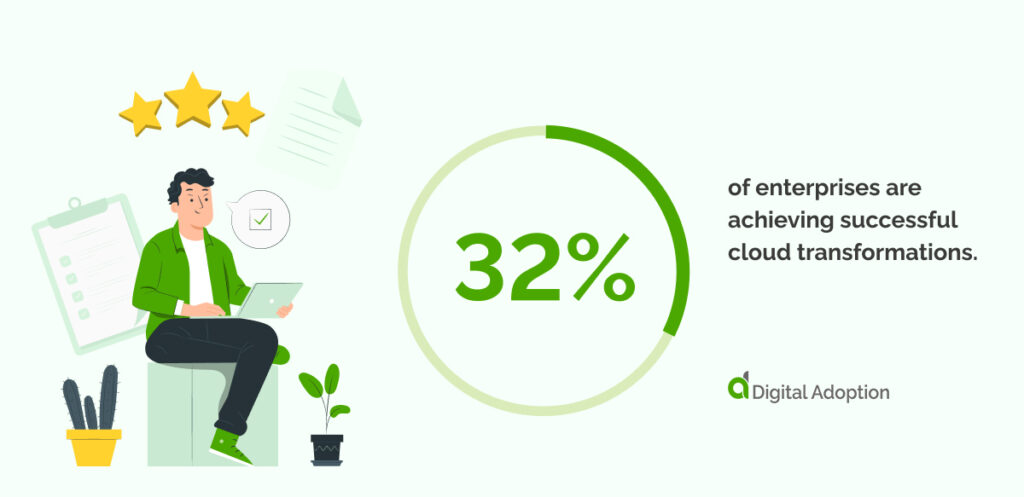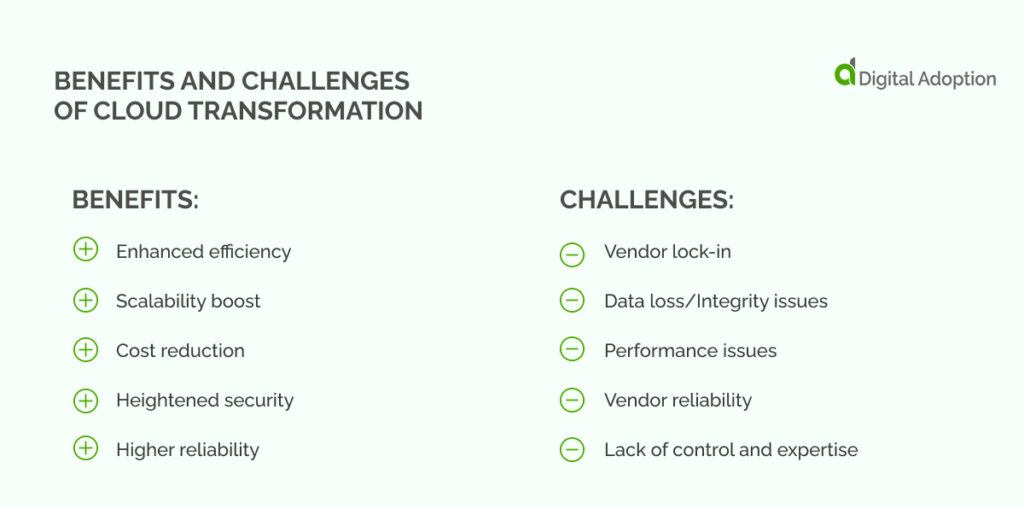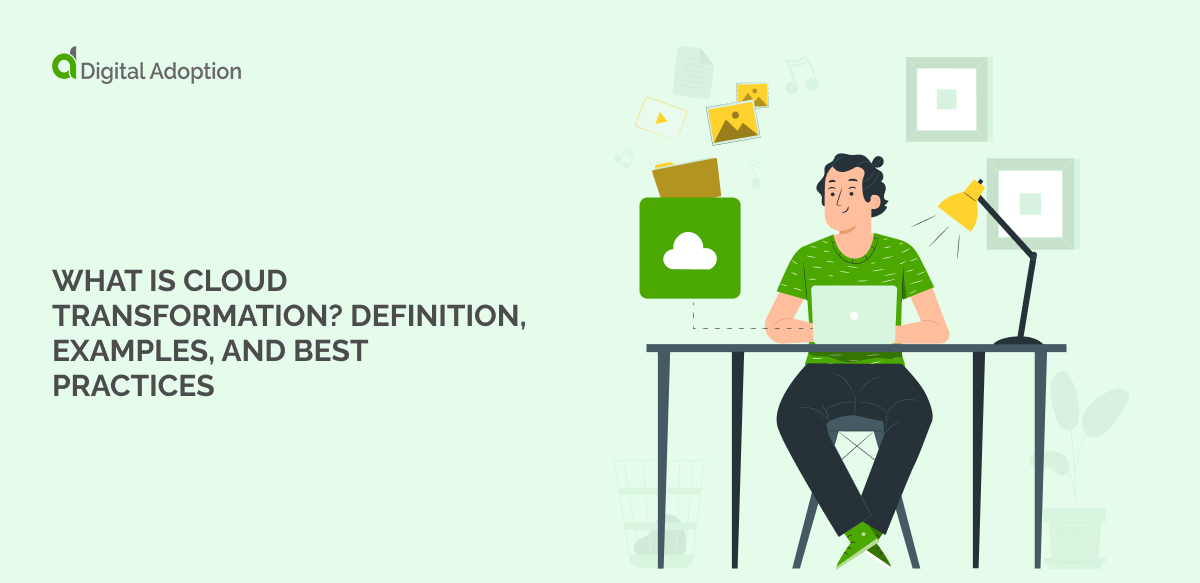If you’re not using the cloud for at least some of your operations and processes, don’t worry. Despite not leveraging the benefits of this technology, you are in the majority of enterprises that have begun cloud adoption efforts.
32% of enterprises are achieving successful cloud transformations. That’s less than a third of enterprises using industry cloud platforms! If you begin your digital transformation using the cloud today, you can beat the competition and increase revenue.

Cloud transformation entails transferring data, apps, and software to the cloud, aligning with digital transformation goals. It facilitates swift adaptation to challenges and nurtures new work methodologies, integrating digital technology adoption for enhanced operational agility.
Harnessing the potential of cloud technology empowers your organization to unlock significant advantages and stay competitive in today’s dynamic digital environment.
Yet, effectively navigating a cloud transformation presents complexities and challenges. Only through adherence to a meticulously crafted strategy can your organization fully capitalize on these benefits.
This article will explore the difference between cloud transformation and digital transformation. It will also define a cloud transformation strategy, examine the benefits and challenges of cloud transformations, and finally, look at examples of successful implementations by industry leaders.

So, let’s understand why everyone has their head in the Cloud today.
- What is the difference between cloud transformation and digital transformation?
- What is a cloud transformation strategy?
- What are some successful examples of cloud transformation?
- What are the best practices for cloud transformation?
- What are the benefits of cloud transformation?
- What are the challenges of cloud transformation?
- Keep it simple for a successful transformation to the cloud
What is the difference between cloud transformation and digital transformation?
On the surface, digital transformation and cloud transformation seem similar. However, after closer inspection, we see these two concepts are very different.
Cloud transformation focuses on migrating systems and processes to cloud infrastructure, optimizing scalability and efficiency.
Digital transformation encompasses broader changes. It integrates digital technologies across all business aspects to drive innovation, enhance customer experiences, and redefine business models.
The best way to distinguish between the two is to understand that while cloud transformation is a component of digital transformation, the latter encompasses organizational and cultural shifts beyond cloud adoption.
What is a cloud transformation strategy?
A cloud transformation strategy outlines an organization’s plan to migrate its IT infrastructure, applications, and data to cloud-based services toward a cloud-centric philosophy. Businesses use it when they seek enhanced scalability, flexibility, and efficiency in their operations.
The strategy involves several aspects. These include assessing current technology, selecting appropriate cloud models, and ensuring security and compliance. These strategies include planning migration, managing fees through cloud cost optimization, and implementing change management. These processes support a successful transition to the cloud.
What are some successful examples of cloud transformation?
Consider examples to best examine cloud transformations and determine whether your organization needs to implement one.
Below are three examples of how well-known organizations moved to cloud operations, with their reasons and the stages they followed to achieve success. Also, note the positive outcomes at the end of each example.
General Electric (GE)
General Electric (GE), a multinational conglomerate, embarked on a comprehensive cloud migration journey to bolster its digital capabilities. Teaming up with Amazon Web Services (AWS), GE seamlessly began its transformation by moving workloads and applications to the cloud.
The migration process comprises several phases, starting with the Design Phase. The current state of applications, databases, and configurations is assessed.
This stage is followed by a workshop with user groups to compare features in GE Digital APM in the Cloud and perform fit-gap analysis, culminating in the creation of a Design Specification document.
As a result, GE achieved a 52% reduction in TCO (total cost of ownership).
What can you learn from this example?
We can learn several points from GE’s transformation. These include:
- Thorough planning: GE’s effort emphasizes the importance of meticulous planning and assessment before cloud migration, ensuring a focused and streamlined process.
- Provider alignment: By learning from GE’s collaboration with Google Cloud, enterprises can understand the significance of choosing a cloud provider that is aligned with technical and organizational requirements.
- Security emphasis: It is possible to gain insights into implementing robust security measures during migration, safeguarding data integrity, and ensuring regulatory compliance in the cloud environment.
Spotify
Spotify is a famous music streaming service that uses cloud technology to improve its large music library and user experience.
In 2016, Spotify entrusted Google Cloud Platform (GCP) with migrating 1,200 online services and data processing DAGs (directed acyclic graphs) from its internal data centers to the cloud.
Cloud migration for a large enterprise presents complex hurdles. Google Cloud provided flexibility, enabling them to choose their migration approach. They migrated services, users, data, and teams separately, with each step involving reliability testing and staff education on GCP’s support, pricing, networking, and products.
By May 2017, Spotify had finished moving to Google Cloud. This decision allowed them to manage all of their infrastructure. This shift empowered their engineers, allowing them to focus on Spotify-specific tasks and speeding up product development.
Spotify previously managed the largest Hadoop cluster in Europe. It was on-premises, processed up to 20,000 daily jobs, and handled over 100 PB of data. After the migration, Spotify kept these clusters but moved them to the cloud. This move greatly sped up data analysis with little effort.
Spotify’s journey with Google Cloud freed them. They no longer had to manage infrastructure. It allowed faster service delivery and innovation.
What can you learn from this example?
We can learn several points from Spotify’s transformation. These include:
- Microservices adoption: Enterprises can learn from Spotify’s embrace of microservices architecture, enabling scalability and flexibility in the cloud environment.
- Efficient data processing: Spotify’s use of Google Cloud services showcases efficient data processing techniques, emphasizing the importance of leveraging cloud-native analytics and event delivery tools.
- Containerization and Kubernetes: By learning from Spotify’s containerized microservices approach and utilizing Kubernetes, enterprises can understand the benefits of container orchestration for managing cloud-native applications effectively.
Consider these examples and how they might apply to your organization. Use the learning points to tailor the examples to your planning and design process as you align your organizational goals and cloud transformation objectives.
What are the best practices for cloud transformation?
Follow these best practices to ensure your cloud transformation succeeds. These best practices start with finding your goals. Then, prioritize the right ones for now.
Assess and prioritize
Thoroughly assess the existing infrastructure and the business requirements. Use the assessment to find workloads suitable for migration. Prioritize based on complexity and business impact.
This approach ensures a focused migration. It maximizes efficiency and cuts disruptions, leading to a smoother move to the cloud. It also helps allocate resources better. Benefits include performance improvements and savings.
Create dependency mapping
To understand their relationships, map how applications, servers, and infrastructure are interdependent. This action provides insights, shows possible migration challenges, and ensures a full strategy.
By spotting dependencies early, organizations can cut risks, simplify migrations, and keep operations running, leading to a smoother move to the cloud.
Plan and design
Develop a detailed migration plan. Design a scalable cloud system for business needs. Stakeholders must collaborate. This action ensures they align with the organization’s goals and provides scalability, security, and compliance.
Good planning and design let organizations use resources effectively. They also make them more agile and able to support growth. This approach leads to better efficiency, saves costs, and gives organizations a competitive edge in the cloud.
Choose the right provider and services
Pick a cloud provider that meets technical needs. It should also match the goals of your organization. Consider factors. These include reliability, services, security, and support.
Picking the right provider ensures access to needed resources and expertise, improves service reliability, and makes it easier to blend cloud operations. This approach boosts performance, scalability, and cost-effectiveness.
Implement robust security measures
Use encryption, access controls, and monitoring tools to protect data while it is in motion and at rest. Use multifactor authentication and network security protocols. These measures will reduce cyber threats.
Robust security measures keep sensitive data safe. They also keep data correct. They ensure compliance with regulations. These measures build trust. They build trust with customers and stakeholders. They also protect business reputation. They also keep business going in the cloud.
What are the benefits of cloud transformation?
Cloud transformation has many benefits, which is why it’s popular in enterprise settings. The first of these benefits is higher efficiency, which saves enterprises time and money by reducing siloed thinking and enhancing collaboration.
Enhanced efficiency
Cloud transformation streamlines operations and boosts productivity by providing seamless access to data and collaboration tools.
By breaking down data silos and enabling remote access to applications and files, cloud technology facilitates collaboration, accelerates decision-making, and enhances overall efficiency within teams. Cloud transformation can become one of your most vital transformation programs.
Scalability boost
Cloud migration enables organizations to scale resources up or down based on demand, enhancing agility and cost-effectiveness.
With on-demand access to compute power and storage capacity, businesses can quickly adapt to changing requirements, avoiding over-provisioning and underutilizing resources, thus maximizing efficiency and cost savings.
Cost reduction
Cloud transformation reduces costs by eliminating the need for on-premise infrastructure and maintenance.
Cloud providers manage hardware maintenance, software updates, and security patches, minimizing operational expenses and freeing up resources for strategic investments, leading to significant cost reductions.
Heightened security
Cloud providers adhere to strict security standards, offering multiple layers of protection against cyber threats.
Advanced security measures such as encryption, access controls, and continuous monitoring safeguard data integrity and confidentiality, reducing the risk of breaches and cyber-attacks.
Higher reliability
Cloud transformation enhances reliability by leveraging advanced technologies like load balancing and auto-scaling.
These technologies distribute traffic across multiple servers and adjust resources dynamically, ensuring consistent performance and minimizing downtime, thereby enhancing overall reliability.
What are the challenges of cloud transformation?
Like any new technology, migrating to the cloud is not a golden ticket. Like any new technique, it has challenges. Vendors offer long contracts with little flexibility, and data loss can occur, causing performance issues. However, there are ways to fix these problems while still enjoying the benefits of your cloud investment.
Vendor lock-in
One of the primary hurdles in transitioning to the cloud is the risk of vendor lock-in. This scenario occurs when applications or data are migrated to a single vendor’s platform, limiting the organization’s flexibility to switch vendors in the future.
To solve this challenge, businesses should consider diversifying their cloud usage, opting for multiple vendors for different services or applications rather than relying solely on one provider.
Data loss/Integrity issues
Data loss or integrity compromises are potential risks when migrating data and applications to the cloud, especially without robust backup procedures.
Having a solid backup plan in place before migration is crucial. It ensures swift data restoration in case of loss, minimizing disruptions and downtime.
Additionally, businesses must prioritize data integrity and implement stringent security measures to safeguard against potential breaches or corruption during migration and beyond.
Performance issues
Transitioning applications and data from on-site servers to virtualized environments within public clouds can trigger performance challenges. Latency and bandwidth limitations across wide area networks (WAN) can hamper performance, necessitating careful planning and optimization.
Organizations should collaborate closely with IT teams and providers to preemptively identify and address potential performance bottlenecks before migration. This proactive approach mitigates the risk of disruptions post-migration.
Vendor reliability
The reliability of chosen vendors is paramount to ensuring uninterrupted service, particularly during critical business operations. Service outages, especially during peak periods, can result in substantial financial losses due to missed revenue opportunities.
Thorough vendor research is essential before committing to any provider. To mitigate this risk, thoroughly evaluate factors such as reliability track record, quality of customer support, and adherence to service level agreements (SLAs).
Lack of control and expertise
Transitioning to the cloud may entail giving up some degree of control over data management to cloud providers. This lack of visibility and control can pose challenges in troubleshooting issues and ensuring data security and compliance.
To address this risk, businesses should strive to understand how they comprehensively manage their data in the cloud. This approach includes clarifying data ownership, access controls, and compliance measures enforced by the provider.
Furthermore, investing in training and upskilling employees to enhance cloud expertise within the organization can empower teams to navigate cloud environments effectively and mitigate risks associated with a lack of knowledge.
Keep it simple for a successful transformation to the cloud
Simplicity is key to a successful cloud transformation.
Simplify processes, focus on important tasks, reduce complexities, and focus on simple migration strategies that align with business objectives.
Choose cloud solutions that are easy to set up and manage. Avoid unnecessary complications.
Communicate clearly and collaborate with stakeholders. This will ensure that everyone understands how the migration will work.
Simplicity helps organizations. It makes moving to the cloud smoother and helps them meet their transformation goals quickly.









